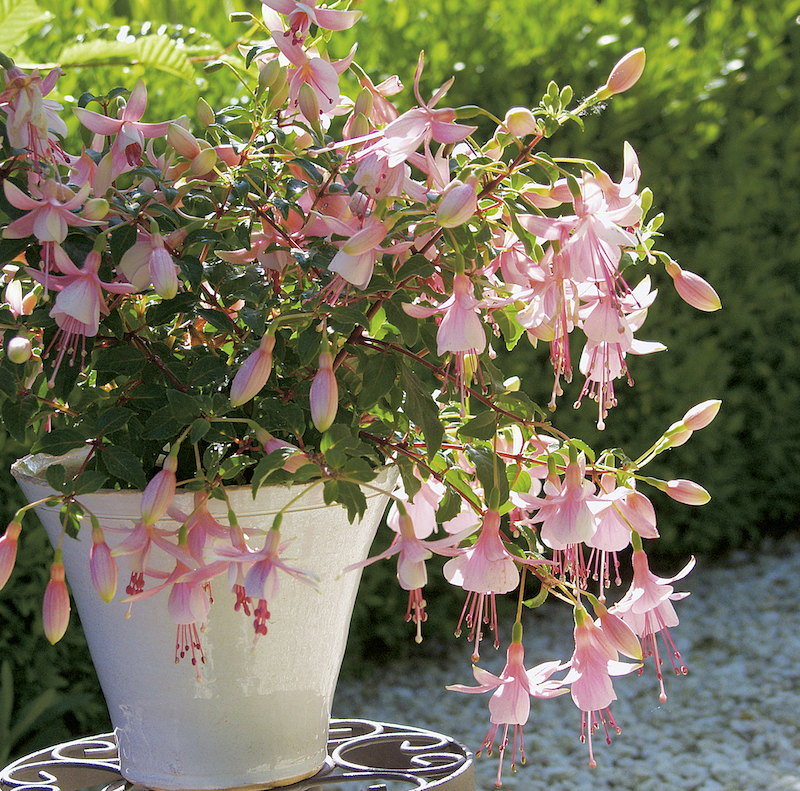Fuchsia is a tender perennial most often grown as an annual in containers and hanging baskets. The hardy varieties, such as F. magellanica, are perennials in zones 6-9 and will easily grow in a container year round. The hybrids, such as F. ‘Swingtime’ or F. ‘Dark Eyes’, are considered annuals in most growing zones but can be overwintered in a frost-free location to plant out the following year.
Fuchsia prefer a considerable amount of shade, especially in hotter growing regions. The perfect spot will have sun in the early morning with close to full shade during the hottest part of the day in late afternoon.

Planting Fuchsia in Pots
Fuchsia are best planted in pots as small starts. These smaller plants will quickly grow robust root systems in just about any container. Plant containers early in the spring as the nighttime temperatures consistently reach around 45 F. If there is a threat of late frost, containers can easily be moved into an unheated garage or greenhouse for the night. If the container is too large to carry, old sheets or horticultural fleece, such as Agribond, can be used to keep frost off the plants.
Fuchsia planted individually will do best in a pot or hanging basket with at least a 10-inch diameter. Drainage needs to be excellent. A plastic liner in hanging baskets will help retain moisture between waterings. Fuchsia that will be overwintered indoors can grow well in terra cotta or other ceramic pots. These pots should spend the winter in an unheated but frost-free spot, making them less likely to crack or break from extreme winter weather. Fuchsia growing as a perennial and spending the winter outside should be planted in a plastic or resin pot.
If you would like to grow perennial fuchsia in a terra cotta or ceramic pot, you can plant it first in a black nursery pot that will easily slide into the more delicate and decorative pot. When the weather turns cold in the fall, the plant can be easily removed and the decorative pot can be stored in the garage or basement.

Best Soil For Fuchsia in Pots
Potting Fuchsia in all-purpose potting soil will give the best results. Mixes that are light with fast drainage help keep the root system healthy. Do not add soil from your garden or compost to the mix. These heavier soils will make the containers too heavy for hanging and cannot drain fast enough. Adding a couple of pieces of broken pots to the bottom of the pot will help to cover drainage holes, so the soil doesn't wash out.
We do not recommend adding a layer of gravel to the bottom of the pot for drainage. The extra layer creates a barrier that impedes drainage. A layer of finely shredded bark, fine gravel, or compost makes a great top dressing to help conserve moisture.
Caring For Fuchsia in Planters
Growing Fuchsia in containers and hanging baskets is a quick way to dress up a deck, patio, or front entryway of the house. The range of available cultivars is sure to suit just about every gardener. These plants are usually grown as flowering annuals, but with a little extra effort, they can continue to grow from year to year.
Watering Fuchsia in Pots
Fuchsia prefers well-draining soil that is also moist. This will mean watering pot-grown plants much more often than those grown in the ground. Letting the top 1-2 inches of soil dry out between waterings keeps Fuchsia from being overwatered, especially in climates with heavy summer rains or high humidity. Pots in humid climates take longer to dry out than those in drier regions.
Smaller pots will also dry out quicker than large planters. During the hottest and driest periods in the summer, check for watering at least once a day. If needed, move the basket or pot into full shade until the weather cools. Always water containers until water emerges from the drainage holes. This will indicate that water has saturated all of the soil evenly.

Fertilizing Fuchsia in Pots
Fertilizing is best done regularly to ensure that Fuchsia continues to bloom well for the growing season. Using a diluted liquid fertilizer such as fish emulsion or seaweed extract will support bloom production without excess foliage growth. Repeated watering of containers leaches nutrients out of the soil. A feed every 2-3 weeks will be needed through August.
Winter Care For Fuchsia in Pots
Fuchsia can be overwintered indoors for regrowth in the spring. It does not matter which USDA zone you grow in; the only requirement is a place that is frost free and dark. When nighttime temperatures drop to 50 degrees F, bring the container into a garage, basement, or unheated greenhouse that will stay above 40 F all winter. The pots can even be stored in an unused closet in the coolest room of your house if you garden in zones 2-3. One-half of the top growth needs cutting back so that the plant can rest.
Keep the plants dry through the winter, watering only once every month or so. As the temperature warms in the spring, set the pots in a brightly lit spot and resume regular watering. New green growth will soon emerge. Prune back any branches to the newest growth. Repot in fresh soil or a bigger pot and place the plants back outside when the nighttime temperatures are above 50 F.
Growing Fuchsia Indoors
Fuchsia can be brought indoors to grow as a houseplant over the winter. The growth will be slower than it was during the summer. Watering is the most critical issue when growing Fuchsia indoors. Overwatering is easily done when the plant slows growth. Drier air can also negatively affect Fuchsia. Using a humidifier or misting device helps. The perfect spot will have bright but indirect light.
 |
Author Robbin Small - Published 9-16-2022 |
